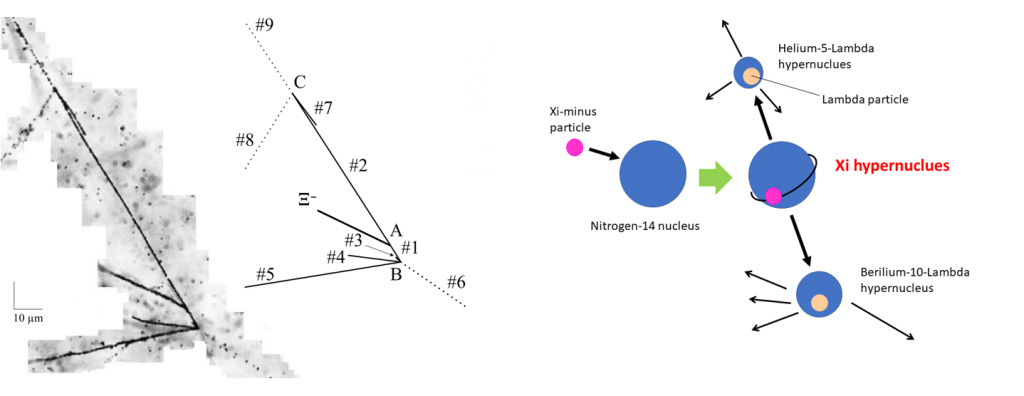
Fig. 1. Microscope image recorded in the emulsion and its schematic drawing of the IBUKI event. : A Xi-minus (Ξ-) particle was absorbed by a Nitrogen-14 nucleus and formed a Xi hypernucleus at point A. It decayed into a Beryllium-10-Lambda hypernucleus (#1) and a Helium-5-Lambda hypernucleus (#2). The Beryllium-10-Lambda hypernucleus decayed into several nuclei (#3-6) and several neutrons (no recorded tracks due to no charge) at point B. The Helium-5-Lambda hypernucleus decayed into a Helium-4 (#7) nucleus, a negative pion (#8), and a proton (#9) at point C.
An international team of 97 researchers from 26 institutes of 6 countries, Japan, Korea, USA, China, Germany, and Myanmar led by Kazuma Nakazawa, a senior professor of Gifu University, observed the decay of a Xi hypernucleus in a nuclear-emulsion experiment carried out at J-PARC, Tokai, Japan.
In the observed event as shown in Fig. 1, which is named “IBUKI” after Ibuki Mountain in Gifu, a Xi-minus particle1), which contains two strange quarks, was bound to a Nitrogen-14 nucleus. By a detailed analysis of the decay products observed in the emulsion, the Xi hypernucleus mass could be precisely determined for the first time. The precise mass measurement of Xi hypernuclei gives information on “strong interaction2)” between a Xi-minus particle and a nucleus, and underlying interaction between a Xi particle and a proton/neutron. Since particles containing strange quark (hyperons1)), such as a Xi-minus particle, are predicted to appear in the core of neutron stars, which are the densest objects in the Universe, then the strength of the interaction leads to an understanding of which hyperons appear in which densities in neutron stars, and hence the structure like the radius and pressure inside. This result, therefore, is expected to contribute the understanding how the matter was formed from quarks, the elementary particles, and what is the structure of interior of neutron stars which are often described as giant nuclei. The result was published online in “Physical Review Letters (PRL)” on Friday 12 February, 2021 (Japan time). The paper was selected as an Editors’ Suggestion and the commentary article was also published in Physics Synopsis ( https://physics.aps.org/articles/v14/s15 ). Microscope image (Fig.1 left) was shown in the cover page of PRL Volume 126 Issue 6 issued on 12 February (USA time).
Here is the press release.
Link
Paper Information
Journal: Physical Review Letters
Title: Observation of Coulomb-Assisted Nuclear Bound State of
Ξ-–14N System
Authors: S. H. Hayakawa et al. (J-PARC E07 Collaboration)
DOI: 10.1103/PhysRevLett.126.062501